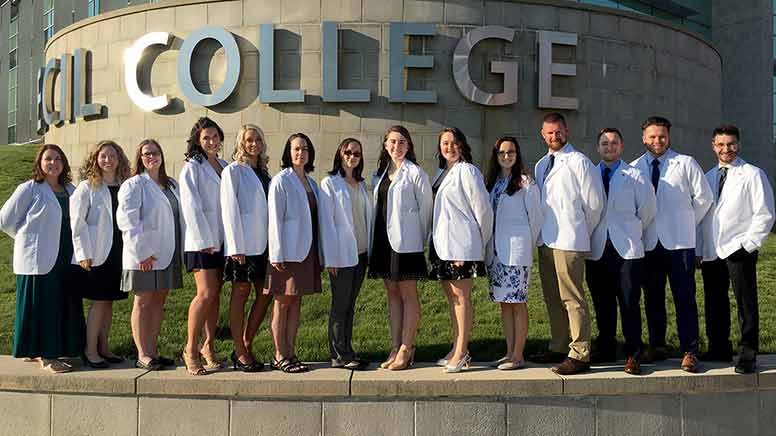PTA graduates achieve perfect pass rate
Published on October 9, 2019

The Class of 2019 stand in front of the Cecil College sign on the North East Campus. From left are: Erin Van Wagner, Monica Yoon, Sandy Surmacz, Emma Daniels, Amanda Tolliver, Stacey Tipton, Reanna Lutz, Kyralee Comeaux, Michaela Kline, Haylee Hill, Nick Poore, Jason Leatherman, Nate Hood, and Cody Rea.
NORTH EAST, Md. – Success in education is no different than prosperity in business. Hard work and collaboration are key. These two traits were instrumental for students in Cecil College’s Physical Therapist Assistant (PTA) program which achieved what few others in the field have.
It was announced last month that 100 percent of the PTA graduates from the May 2019 class passed the National Physical Therapy Exam (NPTE) on their first attempt. Making this accomplishment more monumental is that this is the fourth consecutive year Cecil College’s PTA students have had a 100 percent first attempt pass rate.
“We set the bar and standards high for our PTA students. We expect them to give 100 percent during the technical portion of the curriculum and, in addition, our faculty are dedicated, often spending extraordinary amounts of time with the students to ensure they understand, not just memorize, the material,” said Interim Program Director Deanna Smith, PT, MPT.
Cecil College launched the program in January of 2015, which has exceeded the national and local averages in exam performance in all subject categories on the NPTE. Through collaboration with the other healthcare programs at the College, the PTA students are exposed to expanded aspects of healthcare, and the nursing faculty have been mentors to the new PTA faculty during this inception.
“The Physical Therapist Assistant program is led by dedicated faculty committed to student success. We are very proud of the excellent passage rates our students have achieved for the past three years. I extend sincere congratulations and my appreciation to everyone involved with our PTA program,” said Cecil College President Mary Way Bolt.
In addition to the healthcare programs, the entire College community has been very proactive in providing exceptional support to the PTA program, with robust relationships with the library faculty and staff, the writing center, the career center, advising, admissions and registration.
“It really does take the entire campus community to build a successful program. We have a dynamic relationship with the other health programs that is constantly evolving. Our PTA students and RN students participate in an Inter-Professional Education event each year, enabling them to learn interdisciplinary care planning at the academic level before they both enter the clinical education portion of their curriculum,” said Smith.
According to the U.S. Department of Labor, demand for PTAs is projected to grow 30 percent from now through 2026 with the average starting salary in the State of Maryland being $57,700. Career prospects are favorable for PTAs with more than 96 percent being employed within six months of licensure.
“As clinicians in a doctoring profession, they are expected to possess exceptional clinical reasoning abilities. We focus on professional behaviors and the development of skilled clinicians. The prerequisites create a foundational knowledge on which we can build during the technical portion of the curriculum thanks to the exceptional work of our STEM faculty.” said Smith.
Moving forward, Cecil College’s PTA program is entering the reaffirmation of the accreditation process, which is an exceptional opportunity to evaluate and assess the program’s details and make appropriate adjustments to its methodology.
“We are always looking at new opportunities for our students to participate in clinical education. Facilities and companies that partner with healthcare programs have the benefit of on-boarding a potential employee during their clinical education experience, thereby minimizing the learning curve at the time of hire and maximizing the clinician’s productivity,” said Smith.

